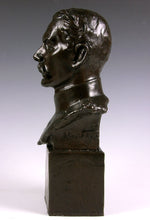Bronze Bust of Field Marshal Lord Kitchener by Albert Toft, Circa 1910
Adding product to your cart
Height overall: 26cm (10.25in)
On an integral bronze base. Modelled in frock coat. Signed beneath the left shoulder.
Albert Toft (1862-1949) was an exponent of the New Sculpture movement as exemplified by Alfred Gilbert’s statue of Anteros (or Eros) atop the Shaftesbury Monument Fountain at Piccadilly Circus. Toft was the son of a ceramics designer and modeller, and studied at Birmingham, and then at Hanley and Newcastle under Lyme Schools of Art. During this time he was also apprenticed to Wedgwood as a modeller. In 1879 he won a National Scholarship to the National Art Training Schools (forerunner of the Royal College of Art), where he studied for two years under Edouard Lanteri. His first great success was with a figure of Lilith (1889, Birmingham Museums and Art Gallery). Other major works include Spring (1897, Birmingham Museums and Art Gallery); The Spirit of Contemplation (1901, Laing Art Gallery, Newcastle upon Tyne); The Metal Pourer (Cardiff, 1913) and The Bather (Chantrey Bequest, Tate Gallery, 1915).
Read more
Throughout his career Toft produced portrait busts, including the artist and curator George Wallis (1890, V&A); Sir George Frampton R.A. (1915); Sir Henry Irving R.A. (1919); and Sir Alfred Gilbert R.A. (1935). After the turn of the century, Toft took up commemorative public sculpture, with figures of Queen Victoria for Leamington (1902) and Nottingham (1905), several Boer War Memorials, including those in Birmingham (1905) and the Welsh National Memorial in Cardiff (1909), and, after the First World War, many more war memorials, notably the Royal Fusiliers (City of London Regiment) Memorial at Holborn Bars, an exact copy of which stands as the 41st Division Memorial at Flers in France. He sculpted the Chadderton War Memorial (1921) in Oldham and the Monument to Captain Albert Ball, V.C., in the grounds of Nottingham Castle. In the years 1923-24 he worked in concert with the Birmingham architects S.N. Cooke and W.N. Twist of Paradise Street and sculpted the seated bronze allegorical figures representing the Navy, Army, Air Force and Women’s Services as an integral part of the design of the Hall of Memory in Centenary Square, Birmingham.
Socially gregarious, Toft was a stalwart of the Savage Club, figuring prominently in their affairs, frequently presiding over their House Dinners. He was elected to the Art Workers Guild in 1891 and his sculptor’s manual, Modelling and Sculpture, was published in 1911. He exhibited at the Royal Academy between 1885 and 1947, and was elected a Fellow of the Royal Society of British Sculptors in 1938.
Sources:
Buckman, D., (1998) Dictionary of Artists in Britain since 1945, Bristol
MacKay, J., (1977) Dictionary of Western Sculptors in Bronze, Woodbridge
Ward-Jackson, P., (2003) Public Sculpture of the City of London, Liverpool
Who’s Who in Art, 28th edn, London, 1998






